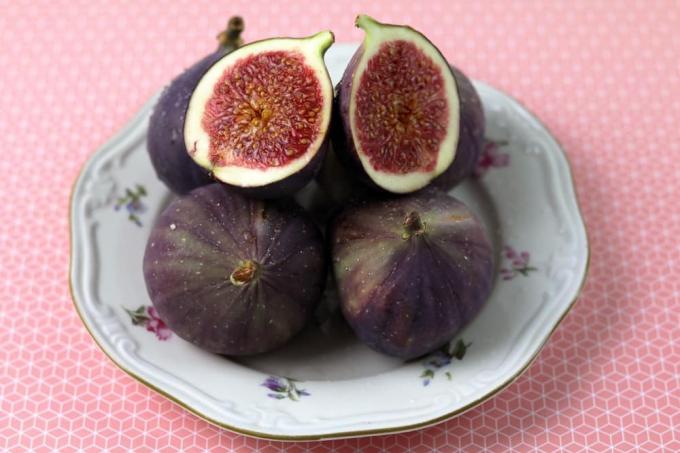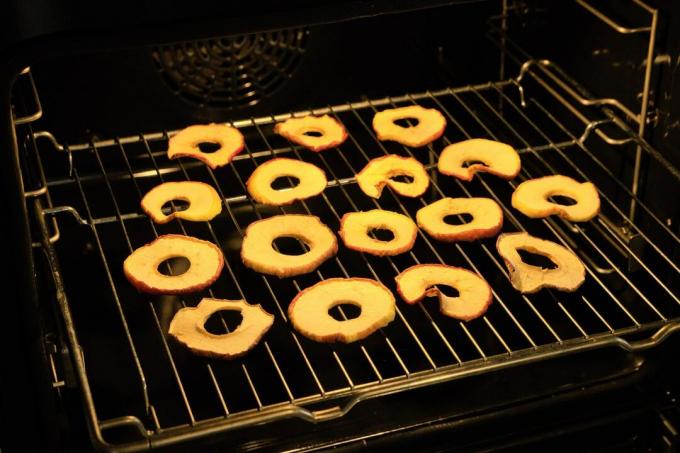

Table of contents
- Why dry fruit?
- Which fruits dry?
- Preparation
- Drying in the oven
- Drying in the microwave
- Air drying outdoors
- After drying
Drying fruit to preserve it is an ancient technique. Thousands of years before our era, people used them almost everywhere in the world not only to be able to eat fruit in summer, but especially in the barren winter. As a rule, a so-called kiln was used, a drying oven that was specially designed for this purpose. Nowadays there are dehydrators in specialist shops that make drying child's play. Of course, you don't have to buy a new device. Oven or microwave will do, too.
Why dry fruit?
There are three main benefits of drying fresh fruit, removing the water it naturally contains. On the one hand, this means that the fruit has a much longer shelf life. The dehydration prevents or minimizes the formation of rot. delayed. At the same time, the relative fructose content increases, which has a preservative effect. How long the individual fruits actually keep is difficult to say. This essentially depends on the type of fruit and the degree of drying. In general, however, it can be said that properly packaged dried fruit can be kept for several months. After the harvest in autumn, you will definitely get through the winter with it. Another advantage is that the fruit tastes sweeter, fruitier and overall more intense after drying. Finally, dried fruit is also healthier, since drying increases its mineral and vitamin content in relation to it. In addition, most dried fruits are also extremely high in fiber and stimulate digestion.
Which fruits dry?
The various types of fruit that are now growing in our gardens are suited to varying degrees of drying. There are absolutely no problems with the following varieties or Species:
- apples
- pears
- figs
- plums
- Grapes
- apricots
Tip:
Always dry immediately after harvest and do not store the fruit until temporarily. This keeps the vitamin content at a higher level.
Preparation

In order to be able to dry fruit perfectly, a few small preparatory works are required. Of course, it has to be harvested first. You should then wash it with clear water. Once that's done, all the fruits are peeled and any seeds removed. It is strongly recommended to cut larger fruits such as apples or pears into thin slices. The thinner the slices are, the easier and quicker they can be dried. If you value your dried fruit making a visually fresh and tempting impression, briefly soak the fresh fruit in diluted lemon juice before drying.
Drying in the oven
If you don't have a dehydrator and don't want to buy one, it's best to use the oven in the kitchen to dry the fresh fruit. A so-called convection oven, which allows the warm air to circulate constantly in the tube, is really perfect for this. But the whole thing also works relatively easily with simple bottom and top heat. Of course, the temperature is of great importance. It should be on the lowest setting of the oven, which is usually 50 degrees Celsius. Under no circumstances should these 50 degrees be exceeded, otherwise there is a risk that the fruit will not be dried but baked. The drying process is as follows:
- Lay out several layers of parchment paper on the oven tray to absorb the moisture
- Spread the sliced fruit on top, making sure they don't stick to each other
- Always leave the oven door ajar, for example by squeezing in a wooden spoon, so that the moisture can escape
- Turn the fruit about every 15 minutes
How long the fruit has to dry cannot be said in general terms. The only thing that usually helps here is to test the degree of drying by hand from time to time. A shriveled surface on some fruits is also an indication that most of the water has escaped from it. This is especially true for grapes, plums and apricots.
Drying in the microwave
After the dehydrator and the oven, the microwave is the third best way to dry fruit sensibly and in a reasonable amount of time. However, you should be aware that most vitamins and minerals are lost when drying with this device - at least significantly more than in the oven. How to proceed:
- first heat the fruit in the microwave at maximum power for about two minutes
- then open the door to let the moisture escape
- then leave the fruit in the microwave on the lowest setting for about 20 to 30 minutes
- Open the door briefly every two to three minutes to allow the moisture to escape
The importance of removing moisture during drying should never be underestimated. This applies to both the oven and the microwave. If you don't open the door regularly and the moisture remains in the device, the fruit will at best be cooked, but not really dry.
Air drying outdoors

It doesn't matter whether it's in the oven or microwave - fruit that is too dry in these devices always means high power consumption. This is neither good for the wallet nor for the environment. If you want to save money and protect nature, you can fall back on good old air drying outdoors. However, one should be aware that this method takes a lot of time. In addition, the fruits must be well protected from birds and insects. All in all, air drying is therefore not necessarily recommended.
After drying
Dried fruit is best stored well wrapped and protected. Plastic bags or plastic containers are particularly suitable as packaging. Metal cans, on the other hand, are less good, as there is a risk that the fruit acid that is still present will react with the metal. Dried fruits can be used in many ways. They taste just as good as a sweet snack as they do as a fruit in muesli. But the fruit can also be used for baking. However, it is advisable to soak the dried fruit in water first. This ensures just the juiciness that is needed for a delicious cake, for example, without losing the sweetness and intense taste.
 garden editorial
garden editorial I write about everything that interests me in my garden.
Learn more about harvesting fruit

Harvesting walnuts: how to clean and store them properly | washing necessary?
Harvesting, cleaning and drying walnuts made easy! Read here how you can store walnuts for up to two years!

Skin, peel, core the peaches - that's how it works!
Many a fruit lover has to put up with sticky fingers, mushy pulp and a lot of frustration, when he's desperately trying to prepare his favorite fruit ready to eat: peaches are hard to eat process! But are there also easy ways to skin and core your favorite fruit?

Drying figs – this is how you dry them with sun, oven and microwave
Drying figs makes them both durable and delicious, natural sweets. In addition, dehydrating with the sun, oven or microwave is very easy, but requires a lot of patience - and the right approach. We reveal what to look out for and how it works.

Fruits and fruits themselves dry in the oven
The drying of fruit and fruit is also referred to as dehydration and has been known in this form for centuries. It is one of the oldest methods of preserving food. Learn how it works here.

Meadow orchard: Creating and maintaining | What is allowed?
If you want to create a meadow orchard, you have to find out about regulations, maintenance and building law in advance. A subsidy for this contribution to nature conservation is also available, which means that the investment can be worthwhile, especially in the long term.

Harvesting Boskop apples: when is the harvest time in 2022?
The Boskop (actually "Der Schöne aus Boskoop") is an old apple variety that is still very popular. It is versatile and can be stored for a long time. The right harvest is crucial for a long shelf life. When the time has come in 2022 and what needs to be considered is available here in the guide.



